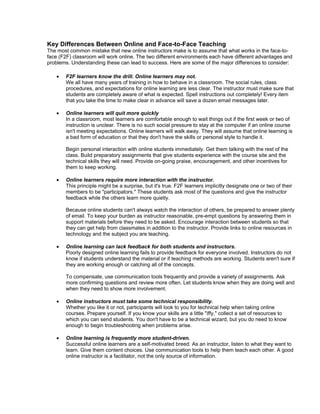
Key differences between face2face and online teaching
- 1. Key Differences Between Online and Face-to-Face Teaching The most common mistake that new online instructors make is to assume that what works in the face-to- face (F2F) classroom will work online. The two different environments each have different advantages and problems. Understanding these can lead to success. Here are some of the major differences to consider: • F2F learners know the drill. Online learners may not. We all have many years of training in how to behave in a classroom. The social rules, class procedures, and expectations for online learning are less clear. The instructor must make sure that students are completely aware of what is expected. Spell instructions out completely! Every item that you take the time to make clear in advance will save a dozen email messages later. • Online learners will quit more quickly In a classroom, most learners are comfortable enough to wait things out if the first week or two of instruction is unclear. There is no such social pressure to stay at the computer if an online course isn't meeting expectations. Online learners will walk away. They will assume that online learning is a bad form of education or that they don't have the skills or personal style to handle it. Begin personal interaction with online students immediately. Get them talking with the rest of the class. Build preparatory assignments that give students experience with the course site and the technical skills they will need. Provide on-going praise, encouragement, and other incentives for them to keep working. • Online learners require more interaction with the instructor. This principle might be a surprise, but it's true. F2F learners implicitly designate one or two of their members to be "participators." These students ask most of the questions and give the instructor feedback while the others learn more quietly. Because online students can't always watch the interaction of others, be prepared to answer plenty of email. To keep your burden as instructor reasonable, pre-empt questions by answering them in support materials before they need to be asked. Encourage interaction between students so that they can get help from classmates in addition to the instructor. Provide links to online resources in technology and the subject you are teaching. • Online learning can lack feedback for both students and instructors. Poorly designed online learning fails to provide feedback for everyone involved. Instructors do not know if students understand the material or if teaching methods are working. Students aren't sure if they are working enough or catching all of the concepts. To compensate, use communication tools frequently and provide a variety of assignments. Ask more confirming questions and review more often. Let students know when they are doing well and when they need to show more involvement. • Online instructors must take some technical responsibility. Whether you like it or not, participants will look to you for technical help when taking online courses. Prepare yourself. If you know your skills are a little "iffy," collect a set of resources to which you can send students. You don't have to be a technical wizard, but you do need to know enough to begin troubleshooting when problems arise. • Online learning is frequently more student-driven. Successful online learners are a self-motivated breed. As an instructor, listen to what they want to learn. Give them content choices. Use communication tools to help them teach each other. A good online instructor is a facilitator, not the only source of information.
- 2. • Online learning should be broken into smaller pieces. Because online learners quit quickly and because our attention span for a computer screen is limited, online content should be broken into chunks that take twenty minutes or less to complete. Students can always do more than one piece if their attention span holds. • Online learners are tough media critics. In a classroom, students are often used to receiving documents that convey information without much eye for design. Online, they tend to be tougher critics. We have all been trained by television, movies, and Internet to be harsh media critics. If presentation, content, or design is mediocre, we seek other sources. Information is plentiful online, and we must be selective about what we look at or we won't have enough time to get what we need. In this atmosphere, quality design becomes critical. Despite all these differences, online learning shares some important commonalities with F2F learning. ...And What Remains the Same Despite all of the differences between online and F2F learning, your experience as a classroom instructor is still a good baseline by which to measure your new online methods. A good test for any instructional material put online is to ask "Would this work if I was presenting it as a live, on-site course?" If the answer is no, then start over. Important concepts that remain the same across all kinds of teaching include: • Expectations must be clear for learners. • Lines of communication must be used regularly. • Quality interaction between students is the sign of a successful class. • Instructional design is important. • What students do with content is more important than the content itself. • Self-motivated students will rise to the top. • The ability to motivate student interest is usually more important than the instructor's absolute knowledge of the content. • Quality teaching considers the student as an individual, not just the class as a collective. • Solid planning is rewarded. • Variety of approach and content must be balanced with the comfort of familiar work patterns to obtain the highest success. • Showing students that you care about them makes all the difference. Whether over a computer or in a classroom, every day of teaching remains an adventure! — Excerpted with permission from the North Carolina Community College System’s Principles and Techniques of Online Instruction.